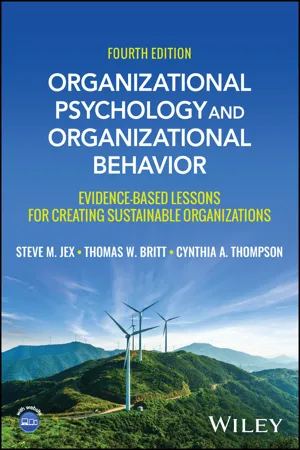Business
Workplace Behavior
Workplace behavior refers to the actions and conduct of employees within a work environment. It encompasses how individuals interact with each other, their work tasks, and the overall organizational culture. Positive workplace behavior contributes to a productive and harmonious work environment, while negative behavior can lead to conflict and decreased morale.
Written by Perlego with AI-assistance
Related key terms
1 of 5
4 Key excerpts on "Workplace Behavior"
- eBook - PDF
- Ricky Griffin(Author)
- 2018(Publication Date)
- Cengage Learning EMEA(Publisher)
Workplace Behavior is a pattern of action by the members of an organization that directly or indirectly influences organizational effectiveness. Important Workplace Behaviors include performance and productivity, absenteeism and turnover, and organizational citizenship. Unfortunately, a variety of dysfunctional behaviors can also occur in organizational settings. 9-7a Performance Behaviors Performance behaviors are the total set of work-related behaviors that the organization expects the individual to display. Thus they derive from the psychological contract. For some jobs, performance behaviors can be narrowly defined and easily measured. For example, an assembly-line worker who sits by a moving conveyor and attaches parts to a product as it passes by has relatively few performance behaviors. He or she is expected to remain at the workstation and correctly attach the parts. Performance can often be assessed quantitatively by counting the percentage of parts correctly attached. For many other jobs, however, performance behaviors are more diverse and much more difficult to assess. For example, consider the case of a research and development scientist at Merck. The scientist works in a lab trying to find new scientific breakthroughs that have com-mercial potential. The scientist must apply knowledge learned in graduate school with experi-ence gained from previous research. Intuition and creativity are also important elements. And the desired breakthrough may take months or even years to accomplish. As we discussed in Chapter 8, organizations rely on a number of different methods for evaluating performance. The key, of course, is to match the evaluation mechanism with the job being performed. 9-7b Withdrawal Behaviors Another important type of work-related behavior is that which results in withdrawal—absen-teeism and turnover. Absenteeism occurs when an individual does not show up for work. - eBook - PDF
Organizational Psychology and Organizational Behavior
Evidence-based Lessons for Creating Sustainable Organizations
- Steve M. Jex, Thomas W. Britt, Cynthia A. Thompson, Cynthia A Thompson(Authors)
- 2024(Publication Date)
- Wiley(Publisher)
At the most general level, it can be defined simply as “all of the behaviors employees engage in while at work.” Unfortunately, this is a rather imprecise definition because employees often engage in behaviors at work that have little or nothing to do with job-specific tasks. For example, in a study of enlisted military personnel, Bialek et al. (1977) found that less than half of the work time of these individuals was spent performing tasks that were part of their job descriptions. Thus, if performance were defined simply in terms of employee behaviors performed while at work, many behaviors that have no relation to organizational goals would be included (e.g., talking with co-workers about a popular TV show). On the other hand, if job performance were confined only to behaviors associated with the tech- nical aspects of the basic tasks employees perform, much productive behavior in the workplace would be excluded. According to Campbell (1990, Campbell & Wiernik, 2015), job performance repre- sents behaviors employees engage in while at work that contribute to organizational goals. This definition is obviously more pre- cise than simply defining performance as all behaviors that employees perform at work. It is also not overly restrictive; job perfor- mance is not confined only to behaviors directly associated with task performance. One other important aspect of this defini- tion is that job performance represents behaviors that are formally evaluated by the organization as part of the employee’s responsibilities and duties. This aspect of the definition distinguishes job performance from the other forms of productive behavior we address later in the chapter. In defining job performance, it is also important that we distinguish it from several related terms. According to Campbell (1990, Campbell & Wiernik, 2015), job perfor- mance should be distinguished from effec- tiveness, productivity, and utility. - eBook - PDF
- Mary Uhl-Bien, Ronald F. Piccolo, John R. Schermerhorn, Jr.(Authors)
- 2023(Publication Date)
- Wiley(Publisher)
Counterproductive work behaviors (CWBs) are actions that purposely disrupt relationships, processes, satisfaction, and performance in the workplace. Workplace bullying is someone acting in an abusive, demeaning, intimidating, or violent manner toward another on a continuing basis. Work–home spillovers occur when what happens at work affects attitudes and behaviors at home. 3-24 CHAPTER 3 Individual Differences 3.3 Study Guide What are attitudes and how do they work? • Attitudes are a predisposition to respond in a certain way to people and things. Though attitudes pre- dispose individuals toward certain behaviors, they do not guarantee that such behaviors will take place. • Individuals desire consistency between their attitudes and their behaviors. When behaviors are incon- sistent with attitudes, people are inclined to experience cognitive dissonance. • Attitudes have affective, cognitive, and behavioral components. What are key job attitudes in the workplace? • Job involvement is a positive attitude that indicates the extent to which an individual is dedicated to a job. • Organizational commitment is a positive attitude that shows up in the loyalty of an individual to the organization. • Employee engagement is a deep connection with the organization and a passion for one’s job. • Job satisfaction is an attitude toward one’s job, coworkers, and workplace. The five components of job satisfaction are the work itself, quality of supervision, relationships with coworkers, promotion opportunities, and pay. How do attitudes drive behavior? • Workers who are more satisfied, engaged, and committed to their jobs are absent less often and have lower turnover. OB in the World The Great Resignation Andriy Popov / Alamy Stock Photo During the first ten months of 2021, 39 million American workers resigned from their jobs, a sensation that earned the label, “The Great Resignation.” As reported by Te-Ping Chen and Ray A. - eBook - PDF
- Ricky Griffin(Author)
- 2021(Publication Date)
- Cengage Learning EMEA(Publisher)
Similarly, the social context in which the person works, or the work group, will need to facilitate and absenteeism When a person does not show up for work turnover When people quit their jobs organizational citizenship The behavior of individuals that makes a positive overall contribution to the organization PART 5 | The Leading Process Copyright 2022 Cengage Learning. All Rights Reserved. May not be copied, scanned, or duplicated, in whole or in part. Due to electronic rights, some third party content may be suppressed from the eBook and/or eChapter(s). Editorial review has deemed that any suppressed content does not materially affect the overall learning experience. Cengage Learning reserves the right to remove additional content at any time if subsequent rights restrictions require it. 409 CHAPTER 14 | BASIC ELEMENTS OF INDIVIDUAL BEHAVIOR IN ORGANIZATIONS promote such behaviors (we discuss group dynamics in Chapter 18). And the organization itself, especially its culture, must be capable of promoting, recognizing, and rewarding these types of behaviors if they are to be maintained. Research suggests that organizational citizen- ship may play an important role in organizational effectiveness. 53 14-7d Dysfunctional Behaviors Some work-related behaviors, however, are dysfunctional in nature. Dysfunctional behaviors are those that detract from, rather than contribute to, organizational performance. 54 Two of the more common ones, absenteeism and turnover, have already been discussed. But other forms of dysfunctional behavior may be even more costly for an organization. Theft and sabotage, for example, result in direct financial costs for an organization. Sexual and racial harassment also cost an organization, both indirectly (by lowering morale, producing fear, and driving off valuable employees) and directly (through financial liability if the organization responds inappropriately).
Index pages curate the most relevant extracts from our library of academic textbooks. They’ve been created using an in-house natural language model (NLM), each adding context and meaning to key research topics.



